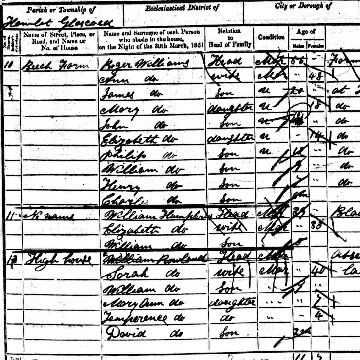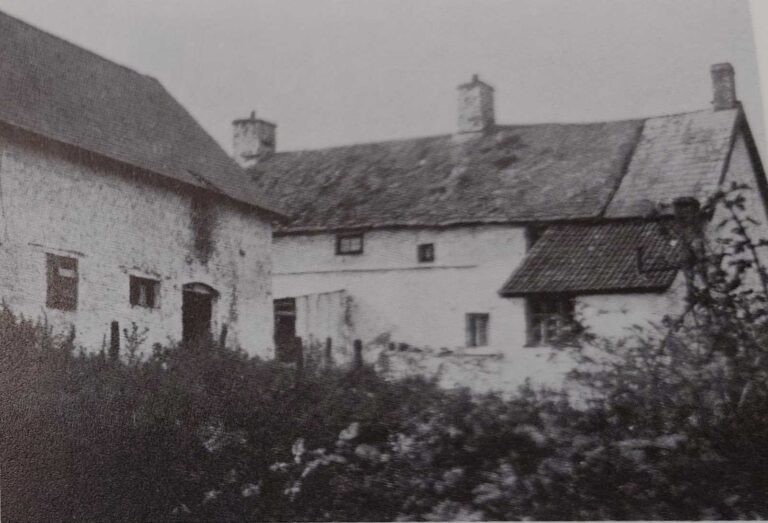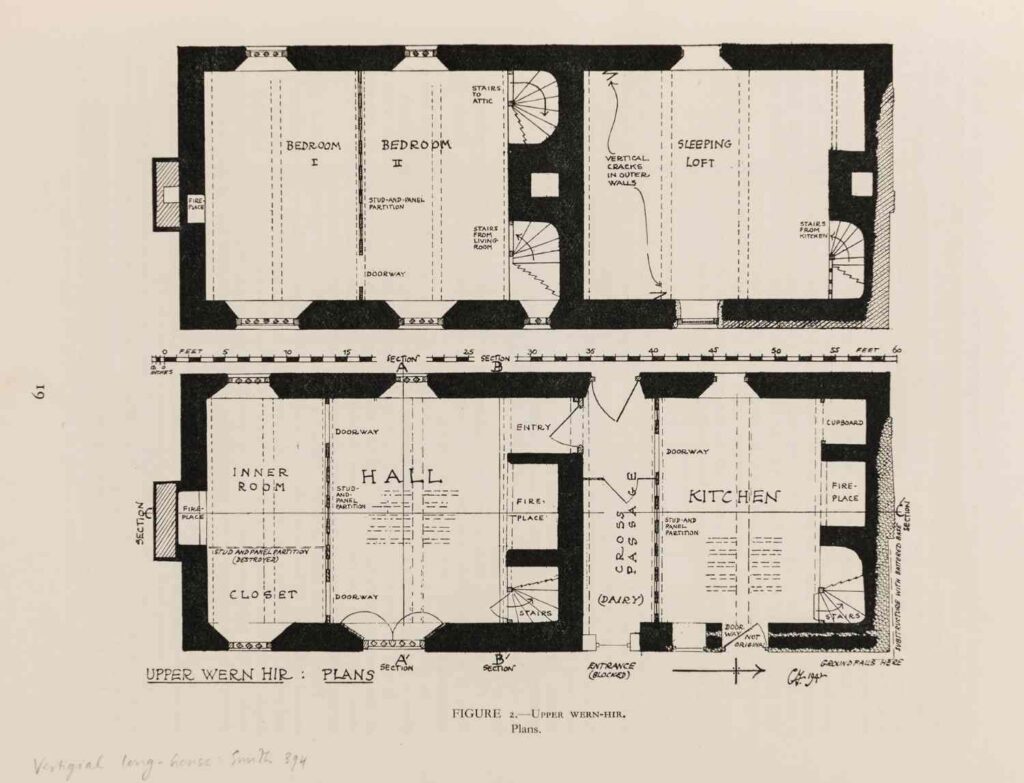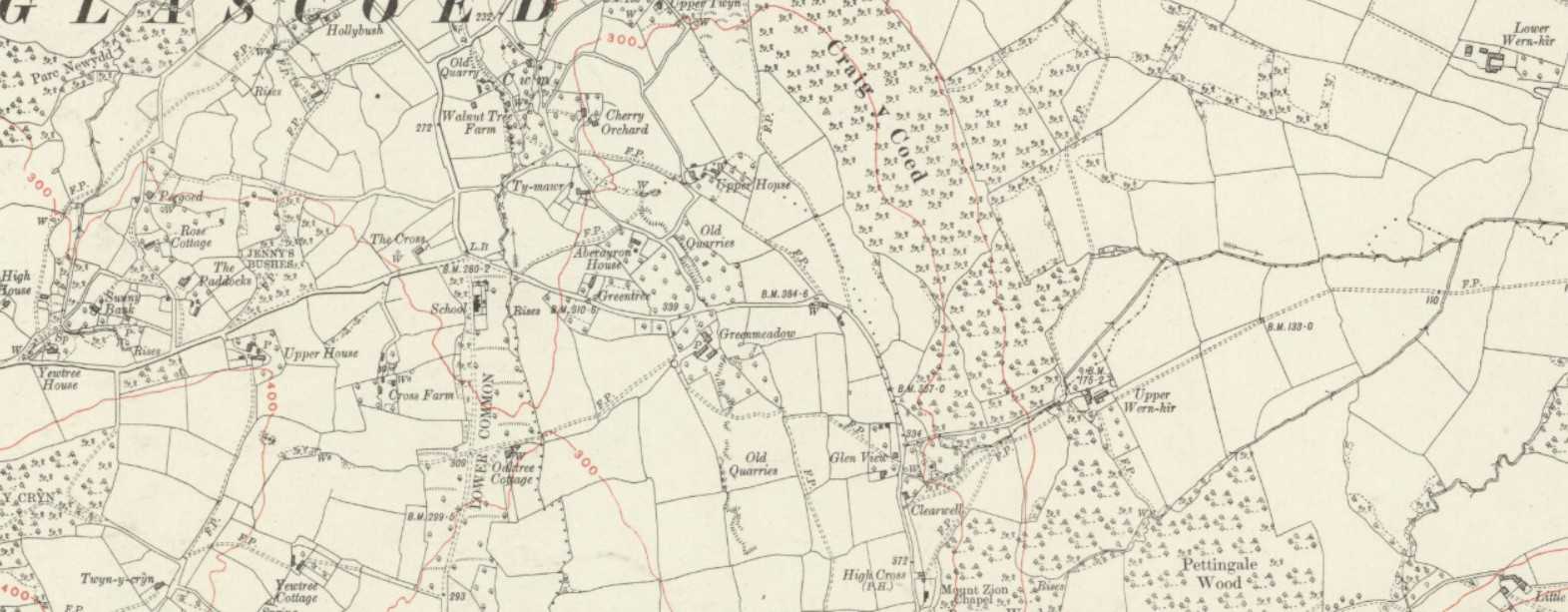Overview
Upper Wernhir is a farmhouse, which whilst situated just outside of Glascoed’s boundaries, on the North-Western fringe of Llanbaddock, had strong links with Glascoed.
This North-East view of the dwelling is one of only two photographs that I have ever seen of Upper Wernhir.
Sadly, the construction of the Royal Ordnance Factory led to the demolition of this historic property. Welsh journals online notes: “Readers may be interested to recall that it was the destruction of Upper Wern-hir farmhouse in Llanbadoc parish “for security reasons” during the construction of R.O.F. Glascoed, which inspired Sir Cyril Fox and Lord Raglan to undertake their wide-ranging and invaluable study, “Monmouthshire Houses: A study of Building techniques and smaller house-plans in the fifteenth to Seventeenth Centuries” (1951).”
Readers interested in finding out more about the history of Upper Wernhir would be well advised to read this book.
The property, as it was viewed shortly before demolition in the late 1930s consisted of the main house and a farm building (on the left hand side of this photograph) which functioned as a barn, stable and a cowshed in one. Fox and Lord Raglan estimate that the farm building dated back to the late seventeenth century.
They also commented that Lower Wernhir was a modern farm-house and that Little Wernhir was now represented only by farm building (in the late 1930s). As mentioned there is a lot of detail in the book, which anyone particularly interested in Upper Wernhir should read. It includes diagrams of the rooms, layout and interesting features. They mention that parts of the house have a medieval feel, untouched by Renaissance design features.
Excerpts from "Monmouthshire Houses" by Sir Cyril Fox & Lord Raglan
Sir Joseph Bradney, in his History of Monmouthshire, remarks that in the hamlet of Glascoed “there are three farms called Wern-hir …” (the long meadow). “In 1295 Wern-hir, in the inquisition of Gilbert de Clare, Earl of Hereford and Gloucester, is said to consist of 200 acres … purchased by Sir Bogo de Clare … who had died without issue, when his estates reverted to the earl.”[1]
Upper Wern-hir (Plate II A and B) stood on the eastern-facing slope of Craig-y-coed, backed by the wood and fronting its farmlands. The farm building seen in Plate II B, set at right angles to the house, was a barn, stable and cowshed in one, probably dating from the late seventeenth century. The house, built on a rectangular plan, was of two stories with attics, and measured 58 ft. by 23 ft. It was rubble-walled, whitewashed, and roofed with local stone (in part replaced by Welsh slates owing to a construction weakness (p.26). The walls were up to 2 ft. 6 in. thick on the lower (eastern) side, with slight batter at the northern end where the ground slopes, 2 ft. elsewhere. The main axis of the house was nearly north and south; of the three chimney stacks on at the south gable projected, and had two offets on one side; it is no doubt an (early) addition.[2]
There was a string-course of slabby stone on the east front, seen in the Plate; its abrupt end marked the point where the first building phase stopped. All the original window frames of this phase survived on this side, and the photographs show those on the upper floor; but on the ground floor they were hidden by a shed. The windows and doors at the service end of the house, built a little later, were replaced in the eighteenth century.
We have concentrated on the east side of Upper Wern-hir because it was, on the whole, better preserved than the other, and because it was the principal front, facing the farm-yard and the valley and including the largest mullioned windows on each of the two floors.
The article goes on to explain the layout of the house and provides a floor plan.
The ground floor consisted of four rooms which were a Kitchen, Dairy, Living room (“Hall”) and Inner room.
The house seemed to be separated between the family quarters (to the right hand side of the front door, and the service quarters (containing the Kitchen), which were to the left. The Dairy was opposite the front door, through a doorway. “The cross-passage was the main traffic-way in the house, giving access from the farm-yard and from garden to the family quarters on the one side, and the service quarters on the other.”
Regarding the family quarters, the “Hall” was also described as the “Living room” and beyond this, at the far end of the building the “inner room” was found, along with a partitioned closet.
In the “Hall” there was a large fireplace in an unusual position below a gable chimney stack. A staircase from the “Hall” led to two adjoining bedrooms. A further staircase from Bedroom 2 led to the Attic bedrooms. These must have been the rooms where the family slept.
The Kitchen contained a fireplace, recessed cupboard and a doorway (“not original”). A second staircase led to a Sleeping loft above the Kitchen, which must have been the servants’ sleeping quarters. The Service and Family Quarters were separate, with no passages adjoining them above the ground floor.
The book itself goes on to explain in great detail what the architectural features of Upper Wernhir were. If you are interested in this level of detail, you would find the book fascinating. It also contains sketches of some of the key features of the house and other significant Monmouthshire houses.
[1] Vol. III, Part I, p. 65. Lower Wernhir is a modern farm-house. Little Wernhir is now represented by farm buildings only.
[2] See p. 26; also C. Fox “Some South Pembrokeshire Cottages,” Antiquity, 1942, pp. 307-19, for this type of chimney stack.
Facts and Figures

Year of Construction
A dwelling at Wernhir was mentioned as being in existence as early as 1295. The house was re-constructed and added to several times over the centuries.

First Recorded Residents and year
Sir Bogo de Clare bought Wernhir in 1295. Richard & Mary Williams and family, with a large household, appear on the 1841 census. I am sure that there are other records out there of earlier residents.

Residents at time of the 1851 census
John and Eliza Williams and family.
Location
Upper Wernhir’s site is now on the BAE Glascoed munitions factory site, having been demolished to make way for the factory in the 1930s. I have added a marker which approximates where Upper Wernhir was situated, having checked the “Old maps” reproduced above.
Residents
Summary
The residents of the farmhouse in the period of the censuses were named:
- Williams (1841 and 1851)
- Morgan (1861 and 1871)
- Jones (1881 and 1891)
- Edmunds (1901 and 1911) and
- Gwatkin (1921).
Richard and Mary Williams and family
Richard Williams, who had been born in approximately 1776 at Mochdre, Montgomeryshire was farming Upper Wernhir at the time of the 1841 census with his family. Mary was a Monmouthshire girl, ten years his junior. By 1851 Richard had moved to nearby Pontnewydd, where he was a “proprietor of houses”. He died in 1857.
1841 census:
Upper Wernhir
- Richard Williams, 65, , Farmer, N
- Mary Williams, , 55, , Y
- Ann Williams, , 25, , N
- Thomas Williams, 25, , , N
- John Williams, 20, , , N
- Sarah Williams, , 15, , N
- John Jenkins, 13, , M S, Y
“N” denotes that the person was not born in the County of Monmouthshire. “Y” that they were.
John Edward and Eliza Williams and family
At some point in the intervening decade, Richard’s son, John Edward Williams took over the farm. He was there at the time of the 1851 census, although soon left Upper Wernhir for Steppes farm, Gwernesney, probably by the end of 1851. John Edward’s wife, Eliza was the sister of Cornelius Evans, who came to farm at Glascoed Fach farm by 1881.
1851 census
# 35. Upper Wernhere
- John Williams, Head, M, 32, , Farmer of 260 Acres employing 3 Lab, Montgomeryshire, Mochdre
- Eliza Williams, Wife, M, , 26, Farmers Wife, Monmouthshire, Landenny
- Emily Williams, Daur, , , 2, Farmers Daur, Monmouthshire, Lanbaddock
- Eliza Williams, Daur, , , 6m, Farmers Daur, Monmouthshire, Lanbaddock
- Mary Morgan, Visitor, W, , 46, , Gloucestershire, Olveston
- John Morgan, Visitor, U, 11, , , Monmouthshire, Usk
- Joseph Morgan, Visitor, , 8, , , Monmouthshire, Usk
- Ann Morgan, Visitor, , , 5, , Monmouthshire, Lanwenarth
- Emma Morgan, Visitor, , , 2, , Monmouthshire, Lanwenarth
- Howel Williams, Servant, U, 14 (poss 15?), , Farm servant, Monmouthshire, Lanvrechva
- John Whit, Servant, , 21, , Farm servant, , N.K. (K. = “Not known”).
- Margaret Mitchel, Servant, , , 22, House servant, , Ireland
In 1856, Mary Morgan of Upper Wernhir’s name appears in an article in the Usk Observer after one of her dogs had been accused of worrying and killing a large number of sheep. This indicates that Mary was the householder certainly by this point. She was also noted to be a visitor to the farm in 1851 along with her family. Perhaps they were longer term visitors?
Mary Morgan and family
This is where we see Mary and her family as the main residents at the farm. I wonder what their link to the Williams family may be. Could they be relatives, or simply the next tenants after John and Eliza Williams?
1861 census
#10. Lower Whernheer (Note: this was actually Upper Wernhir).
- Mary Morgan, Head, Un, , 52, Farmer of 84 acres employing one Boy, Gloucestershire, N.K.
- John Morgan, Son, Un, 20, , Farmer’s son, Monmouthshire, Usk
- Joseph Morgan, Son, Un, 17, , Farmer’s son, Monmouthshire, Usk
- Ann Morgan, Daur, Un, , 14, Farmer’s daughter, Monmouthshire, Abergavenny
- Emma Morgan, Daur, Un, , 11, Farmer’s daughter, Monmouthshire, Abergavenny
- Richard Boyce, Serv, Un, 14, , Agricul-l Lab, Monmouthshire, Llanbaddock
John and Emma Morgan and family
Mary’s son John had taken over the farm by this point. I wonder what happened to Mary.
John Morgan had married Emma Arthur (born c. 1837 at Llandegveth) on 31st December 1866 at St. Woolos, Newport. Their marriage certificate shows that John’s father was William Morgan, a Farmer and that Emma was the daughter of William Arthur, also a farmer. Other records point to John’s father William Morgan having also worked as a Haulier (1841 census at Usk) and Hay Dealer (John’s baptism record in February 1840 at Usk).
We see the acreage that John farmed at this point in the census and two children, one of whom had been born in Llangibby in 1867 or 1868 and the other at Llanbaddock (presumably at Upper Wernhir).
1871 census
#7. Wernhir Upper.
John Morgan, Head, Mar, 31, , Farmer of 86 acres of Land, Usk, Monmouthshire
Emma Morgan, Wife, Mar, , 31, , Llandegveth, Monmouthshire
Annie, Morgan, Daur, , , 3, , Llangibby, Monmouthshire
William Arthur Morgan, Son, , 1, , , Llanbaddock, Monmouthshire
Julia Pritchard, Serv, Unm, , 17, Domestic servant, Trelick, Monmouthshire.
The 1881 census for Llandaff, Glamorgan shows that John and Emma had moved to that parish in the outskirts of Cardiff, where John was working as a Gardener. By now they had six children. We know about Annie and William Arthur. There were two more children born in Llanbaddock (Elizabeth aged 9 and Roland Arthur was aged 7). There was then a gap and then the youngest children, Emma (aged 1) and Albert A. (aged 1 month) were born in Llandaff.
John died and was buried at Llandaff Cathedral in 1902. Emma outlived John significantly and was buried with him after her death on 7th January 1927. Their gravestone mentions that Albert Arthur Morgan and a daughter named Winifred had died in Infancy (with the inscription: “Thy Will be done”).
The Jones family
The Jones family had taken over the farm by 1881. They were from Grosmont in Monmouthshire and had farmed at Little Campstone Farm. In 1871, Little Campstone farm had consisted of 45 acres, so the move to Lower Wernhir was a step upwards in scale.
The 1881 census record shows Richard and Mary Anne Jones in charge of 87 acres at Upper Wernhir, with a son, a daughter and Richard’s brother John. Richard and Mary Ann were both from Grosmont farming families. Richard’s parents (James and Rebecca) had farmed at Upper Dyffryn Farm, a 150 acre farm in Grosmont. Mary Ann’s parents (John and Sarah Roberts) had farmed at Tresenny Farm, Grosmont.
1881 census
#85. Upper Wernhir
Richard Jones, Head, Mar, 57, , Farmer of 87 Acres, Monmouthshire, Grosmont
Mary Anne Jones, Wife, Mar, , 50, Farmers wife, Monmouthshire, Grosmont
John Jones, Son, Unm, 23, , Farmers son, Monmouthshire, Grosmont
Mary Jones, Daughter, Unm, , 21, Farmers Daughter, Monmouthshire, Grosmont
John Jones, Brother, Unm, 59, , Agricultural Labourer, Monmouthshire, Grosmont.
By census night 1891, Richard and Mary Anne’s son John had taken over the running of the farm from his parents. Richard had died, Mary continued to live at Upper Wernhir with her son, daughter in law and brother in law. Some other relatives too!
1891 census
#9. Upper Wernhir.
- John Jones, Head, M, 32, , Farmer, x, , , Herefordshire, Canton?, , English
- Maria J. Jones, Wife, M, , 27, , , , , Breconshire, Llanvrynych, , English
- Mary Jones, Mother, Wid, , 59, , , , , Monmouth, Grosmont, , English
- John Jones, Uncle, S, 69, , Farm Labourer, , x, , Monmouth, Grosmont, , English
- John H. Gwatkin, Nephew, , 5, , Scholar, , , , Monmouth, Llanbadoc, , English
- Mary J. Harris, Step Daur, , 5, Scholar, , , , Brecon, Crickhowell, , English
James and Mary Jane Edmunds
James William Edmunds was farming here by 1901. His wife Mary Jane was the daughter of William Williams of Pentwyn, Glascoed. They had married in 1900 and employed Mary Jane’s brother William as a Carter at this point. They stayed at the farm for at least a decade and had another four children in the intervening years.
1901 census
#10. Upper Wernhir, Llanbaddock, Monmouthshire. 5 rooms or more.
- James W Edmunds, Head, M, 26, , Farmer, Own account, , Llantarnam, Monmouth, , English
- Mary J. Edmunds, Wife, M, , 18, , , , Glascoed, Monmouth, , English
- William Edmunds, Son, , 5 m, , , , , Glascoed, Monmouth, ,
- William Williams, Brother in law, S, 14, , Carter on Farm, Worker, , Glascoed, Monmouth, , English
1911 census
10, Upper Wernhir, Llanbaddoc, Mon. Farmhouse & Bldgs. 7 rooms.
- James William Edmunds, Head, 35, , Married, , , , , Farmer, , Own account, At home, Llantarnam, Mon, British, English
- Mary Jane Edmunds, Wife, , 27, Married for 10 yrs, 5 children, 5 still living, Farmers wife, , , , Glascoed, Mon, British, English
- William Laurence Edmunds, Son, 9, , , , , , , , , , , Llanbaddoc, Mon, British, English
- Daisy Edmunds, Daughter, , 8, , , , , , , , , , Llanbaddoc, Mon, British, English
- Sarah Anne Doris Edmunds, Daughter, , 6, , , , , , , , , , Llanbaddoc, Mon, British, English
- John Cyril Edmunds, Son, 3, , , , , , , , , , , Llanbaddoc, Mon, British, English
- James Lloyd Edmunds, Son, 2, , , , , , , , , , , Llanbaddoc, Mon, British.
Evan and Edith Gwatkin and family
The 1921 census features a young family from Goytre: Evan Arthur Gwatkin and his wife, Edith (nee Lewis).
Evan and Edith were actually first cousins, once removed.
Put simply, William and Eliza Gwatkin of Goytre, then Maesmawr, Glascoed were Evan’s Grandparents and Edith’s Great-Grandparents.
William and Eliza Gwatkin had spent much of their life in Goytre and had nine children, including George and Anne Gwatkin.
Evan Arthur Gwatkin was the son of George and Edith was the Grand-daughter of Anne. The diagram below illustrates their tree.

Evan Arthur Gwatkin (born in 1883 at Goytre) was the son of George Gwatkin (1855-1917 of Goytre) and Jane Phillips (1853-1919) who was originally from Michaelchurch in Herefordshire.
Evan’s Grandparents were William (1820-1897) and Eliza Gwatkin (1819-1893), who had come to farm at Maesmawr, Glascoed around 1879/1880 and stayed until their deaths. Another of Evan’s Uncles carried on Farming at Maesmawr for some time after his parents’ deaths.
Evan’s wife, Edith was the daughter of William Isaac Lewis and Edith Twissell.
William Isaac Lewis had been brought up on Beech Farm, Glascoed and was the son of Anne Gwatkin (1850-1920 of Goytre) from her first marriage to Isaac Edward Lewis. Anne had come to live at Beech Farm after her second marriage to Philip Williams, who farmed at Beech Farm.
Since Anne was the daughter of William (1820-1897) and Eliza (1819-1893) Gwatkin, this made her Evan’s Aunty and Edith’s Grandmother. Complicated? They probably didn’t think so!
1921 census
#78 Upper Wernhir, Llanbadoc Usk
- Evan A. Gwatkin. Head. Aged 38 and 1 month. Male. Born: Goytre, Monmouthshire. Farmer “Own account. At home.” English speaker.
- Edith Gwatkin. Wife. Aged 24 and 3 months. Goytre, Monmouthshire. “Home duties. At home.” English speaker.
- Lewis George Gwatkin. Son. 8 months. Parents “Both alive.” Goytre, Monmouthshire.
- Ivor Lewis. Visitor. 18 and 3 months. Single. Born Goytre, Monmouthshire. Steel worker. Baldwins Ltd, Pontypool. Lower Mills, Pontypool. “Out of normal work.” English speaker.
Records
Censuses
1841 – Richard and Mary Williams and family.
1851 – John Edward and Eliza Williams and family.
1861 – Mary Morgan and family.
1871 – John and Emma Morgan and family.
1881 – Richard and Mary Anne Jones and family.
1891 – John and Maria Jones and family.
1901 – James and Mary Jane Edmunds.
1911 – James and Mary Jane Edmunds.
1921 – Evan and Edith Gwatkin and family.





